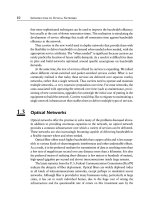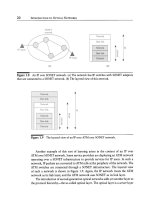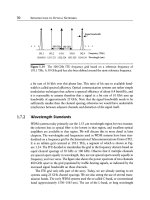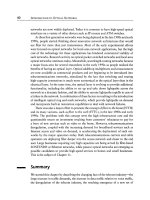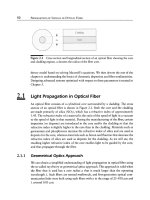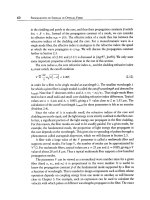Optical Networks: A Practical Perspective - Part 2 doc
Bạn đang xem bản rút gọn của tài liệu. Xem và tải ngay bản đầy đủ của tài liệu tại đây (337.21 KB, 10 trang )
x FOREWORD
enough bandwidth. Between now and the next edition of this book, one may hope
that fiber last mile solutions will finally begin to proliferate, building on the technical
ideas captured here.
There can be no doubt that fiber optic communication can only play an ever
widening, if invisible, role in our lives, and once again, I cannot recommend the
book highly enough to anyone interested in the technical underpinnings.
Foreword
to the First Edition
by Paul E, Green, Jr,
Director, Optical Network Technology (retired)
Tellabs, Inc,
Not too many years ago, whenever one wanted to send messages effectively, there
were really only two choices send them by wire or send them by radio.This situation
lasted for decades until the mid-1960s, when the fiber optics revolution began, qui-
etly at first, and then with increasing force as people began to appreciate that sending
pulses of light through tiny strands of glass wasn't so crazy after all. This revolution
is now in full cry, with 4000 strand miles of fiber being installed per day, just in the
United States alone. Fiber has been displacing wire in many applications, and gradu-
ally it is emerging as one of the two dominant Cinderella transmission technologies
of today, wireless being the other. One of these (wireless) goes anywhere but doesn't
do much when it gets there, whereas the other (fiber) will never go everywhere but
does a great deal indeed wherever it reaches. From the earliest days of fiber com-
munication, people realized that this simple glass medium has incredible amounts of
untapped bandwidth capacity waiting to be mined, should the day come when we
would actually need it, and should we be able to figure out how to tap it. That day
has now come. The demand is here and so are the solutions.
This book describes a revolution within a revolution, the opening up of the
capacity of the now-familiar optical fiber to carry more messages, handle a wider
variety of transmission types, and provide improved reliabilities and ease of use.
In many places where fiber has been installed simply as a better form of copper,
even the gigabit capacities that result have not proved adequate to keep up with
the demand. The inborn human voracity for more and more bandwidth, plus the
growing realization that there are other flexibilities to be had by imaginative use of
the fiber, have led people to explore all-optical networks, the subject of this book.
xi
xii
FOREWORD TO THE FIRST EDITION
Such networks are those in which either wavelength division or time division is used
in new ways to form entire network structures where the messages travel in purely
optical form all the way from one user location to another.
When I attempted the same kind of book in 1993, nobody was quite sure whether
optical networking would be a roaring success or disappear into the annals of "what-
ever happened to " stories of technology that had once sounded great on paper,
but that had somehow never panned out in the real world. My book
(Fiber Optic
Networks,
Prentice Hall) spent most of its pages talking about technology building
blocks and lamenting their limitations since there was little to say about real net-
works, the architectural considerations underlying them, and what good they had
ever done anybody.
In the last four years, optical networking has indeed really happened, essentially
all of it based on wavelength division multiplexing, and with this book Ramaswami
and Sivarajan, two of the principal architects of this success, have redressed the
insufficiencies of earlier books such as mine. Today, hundreds of millions of dol-
lars of wavelength division networking systems are being sold annually, major new
businesses have been created that produce nothing but optical networks, and band-
width bottlenecks are being relieved and proliferating protocol zoos tamed by this
remarkably transparent new way of doing networking; what's more, there is a rich
architectural understanding of where to go next. Network experts, fresh from the
novelties of such excitements as the Web, now have still another wonderful toy shop
to play in. The whole optical networking idea is endlessly fascinating in itself based
on a medium with thousands of gigabits of capacity yet so small as to be almost invis-
ible, transmitters no larger than a grain of salt, amplifiers that amplify vast chunks of
bandwidth purely as light, transmission designs that bypass 50 years of hard-won but
complex coding, modulation and equalization insights, network architectures that
subsume many functions usually done more clumsily in the lower layers of classical
layered architectures~these are all fresh and interesting topics that await the reader
of this book.
To understand this new networking revolution within a revolution, it is neces-
sary to be led with a sure hand through territory that to many will be unfamiliar.
The present authors, with their rare mixture of physics and network architecture
expertise, are eminently qualified to serve as guides. After spending some time with
this book, you will be more thoroughly conversant with all the important issues that
today affect how optical networks are made, what their limitations and potentialities
are, and how they fit in with more classical forms of communication networks based
on electronic time division. Whether you are a computer network expert wondering
how to use fiber to break the bandwidth bottlenecks that are limiting your system ca-
pabilities, a planner or implementer trying to future-proof your telephone network, a
teacher planning a truly up-to-date communication engineering curriculum, a student
FOREWORD TO THE FIRST EDITION
xiii
looking for a fun lucrative career, or a midcareer person in need of a retread, this
volume will provide the help you need.
The authors have captured what is going on and what is going to be going on in
this field in a completely up-to-date treatment unavailable elsewhere. I learned a lot
from reading it and expect that you will too.
This Page Intentionally Left Blank
Contents
Foreword ix
Foreword
to the First Edition
xi
Preface
xxvii
1 Introduction to Optical Networks 1
1.1 Telecommunications Network Architecture 3
1.2 Services, Circuit Switching, and Packet Switching 6
1.2.1 The Changing Services Landscape 9
1.3 Optical Networks 10
1.3.1 Multiplexing Techniques 12
1.3.2 Second-Generation Optical Networks 14
1.4 The Optical Layer 16
1.5 Transparency and All-Optical Networks 24
1.6 Optical Packet Switching 26
1.7 Transmission Basics 28
1.7.1 Wavelengths, Frequencies, and Channel Spacing 28
1.7.2 Wavelength Standards 30
1.7.3 Optical Power and Loss 31
1.8 Network Evolution 32
1.8.1 Early Days Multimode Fiber 33
1.8.2 Single-Mode Fiber 35
XV
xvi
CONTENTS
1.8.3 Optical Amplifiers and WDM 37
1.8.4 Beyond Transmission Links to Networks 39
Summary 40
Further Reading 41
References 42
I Technology 47
2 Propagation of Signals in Optical Fiber 49
2.1 Light Propagation in Optical Fiber 50
2.1.1 Geometrical Optics Approach 50
2.1.2 Wave Theory Approach 55
2.2 Loss and Bandwidth 65
2.2.1 Bending Loss 67
2.3 Chromatic Dispersion 68
2.3.1 Chirped Gaussian Pulses 69
2.3.2 Controlling the Dispersion Profile 74
2.4 Nonlinear Effects 76
2.4.1 Effective Length and Area 77
2.4.2 Stimulated Brillouin Scattering 79
2.4.3 Stimulated Raman Scattering 80
2.4.4 Propagation in a Nonlinear Medium 81
2.4.5 Self-Phase Modulation 83
2.4.6 SPM-Induced Chirp for Gaussian Pulses 87
2.4.7 Cross-Phase Modulation 89
2.4.8 Four-Wave Mixing 90
2.4.9 New Optical Fiber Types 93
2.5 Solitons 98
2.5.1 Dispersion-Managed Solitons 100
Summary 101
Further Reading 102
Problems 103
References 104
3 Components 107
3.1 Couplers 108
3.1.1 Principle of Operation 110
3.1.2 Conservation of Energy 111
3.2 Isolators and Circulators 112
3.2.1 Principle of Operation 113
CONTENTS xvii
3.3 Multiplexers and Filters 115
3.3.1 Gratings 118
3.3.2 Diffraction Pattern 122
3.3.3 Bragg Gratings 123
3.3.4 Fiber Gratings 126
3.3.5 Fabry-Perot Filters 130
3.3.6 Multilayer Dielectric Thin-Film Filters 133
3.3.7 Mach-Zehnder Interferometers 135
3.3.8 Arrayed Waveguide Grating 139
3.3.9 Acousto-Optic Tunable Filter 143
3.3.10 High Channel Count Multiplexer Architectures 148
3.4 Optical Amplifiers 151
3.4.1 Stimulated Emission 152
3.4.2 Spontaneous Emission 153
3.4.3 Erbium-Doped Fiber Amplifiers 154
3.4.4 Raman Amplifiers 159
3.4.5 Semiconductor Optical Amplifiers 161
3.4.6 Crosstalk in SOAs 165
3.5 Transmitters 165
3.5.1 Lasers 166
3.5.2 Light-Emitting Diodes 176
3.5.3 Tunable Lasers 178
3.5.4 Direct and External Modulation 186
3.5.5
Pump Sources for Raman Amplifiers 190
3.6 Detectors 192
3.6.1 Photodetectors 192
3.6.2 Front-End Amplifiers 197
3.7 Switches 199
3.7.1 Large Optical Switches 201
3.7.2 Optical Switch Technologies 207
3.7.3 Large Electronic Switches 215
3.8 Wavelength Converters 216
3.8.1 Optoelectronic Approach 217
3.8.2 Optical Gating 218
3.8.3 Interferometric Techniques 220
3.8.4 Wave Mixing 223
Summary 224
Further Reading 225
Problems 226
References 232
xviii
CONTENTS
4 Modulation and Demodulation 239
4.1 Modulation 239
4.1.1 Signal Formats 240
4.2 Subcarrier Modulation and Multiplexing 242
4.2.1 Clipping and Intermodulation Products 243
4.2.2 Applications of SCM 245
4.3 Spectral Efficiency 245
4.3.1 Optical Duobinary Modulation 246
4.3.2 Optical Single Sideband Modulation 248
4.3.3 Multilevel Modulation 249
4.3.4 Capacity Limits of Optical Fiber 249
4.4 Demodulation 250
4.4.1 An Ideal Receiver 252
4.4.2 A Practical Direct Detection Receiver 253
4.4.3 Front-End Amplifier Noise 254
4.4.4 APD Noise 255
4.4.5 Optical Preamplifiers 255
4.4.6 Bit Error Rates 258
4.4.7 Coherent Detection 263
4.4.8 Timing Recovery 265
4.4.9 Equalization 266
4.5 Error Detection and Correction 267
4.5.1 Reed-Solomon Codes 270
4.5.2 Interleaving 271
Summary 272
Further Reading 273
Problems 274
References 279
5 Transmission System Engineering 283
5.1 System Model 283
5.2 Power Penalty 284
5.3 Transmitter 287
5.4 Receiver 288
5.5
Optical Amplifiers 289
5.5.1
Gain Saturation in EDFAs 290
5.5.2
Gain Equalization in EDFAs 292
5.5.3
Amplifier Cascades 293
5.5.4
Amplifier Spacing Penalty 294
CONTENTS xix
5.5.5 Power Transients and Automatic Gain Control 296
5.5.6 Lasing Loops 298
5.6 Crosstalk 299
5.6.1 Intrachannel Crosstalk 299
5.6.2 Interchannel Crosstalk 301
5.6.3 Crosstalk in Networks 303
5.6.4 Bidirectional Systems 303
5.6.5 Crosstalk Reduction 305
5.6.6 Cascaded Filters 307
5.7 Dispersion 308
5.7.1 Chromatic Dispersion Limits: NRZ Modulation 309
5.7.2 Chromatic Dispersion Limits: RZ Modulation 311
5.7.3 Dispersion Compensation 314
5.7.4 Polarization-Mode Dispersion (PMD) 320
5.8 Fiber Nonlinearities 323
5.8.1 Effective Length in Amplified Systems 323
5.8.2 Stimulated Brillouin Scattering 325
5.8.3 Stimulated Raman Scattering 326
5.8.4 Four-Wave Mixing 329
5.8.5 Self-/Cross-Phase Modulation 333
5.8.6 Role of Chromatic Dispersion Management 335
5.9 Wavelength Stabilization 335
5.10 Design of Soliton Systems 336
5.11 Design of Dispersion-Managed Soliton Systems 338
5.12 Overall Design Considerations 341
5.12.1 Fiber Type 341
5.12.2 Transmit Power and Amplifier Spacing 342
5.12.3 Chromatic Dispersion Compensation 343
5.12.4 Modulation 343
5.12.5 Nonlinearities 344
5.12.6 Interchannel Spacing and Number of Wavelengths 344
5.12.7 All-Optical Networks 345
5.12.8 Wavelength Planning 346
5.12.9 Transparency 348
Summary 348
Further Reading 348
Problems 349
References 356




